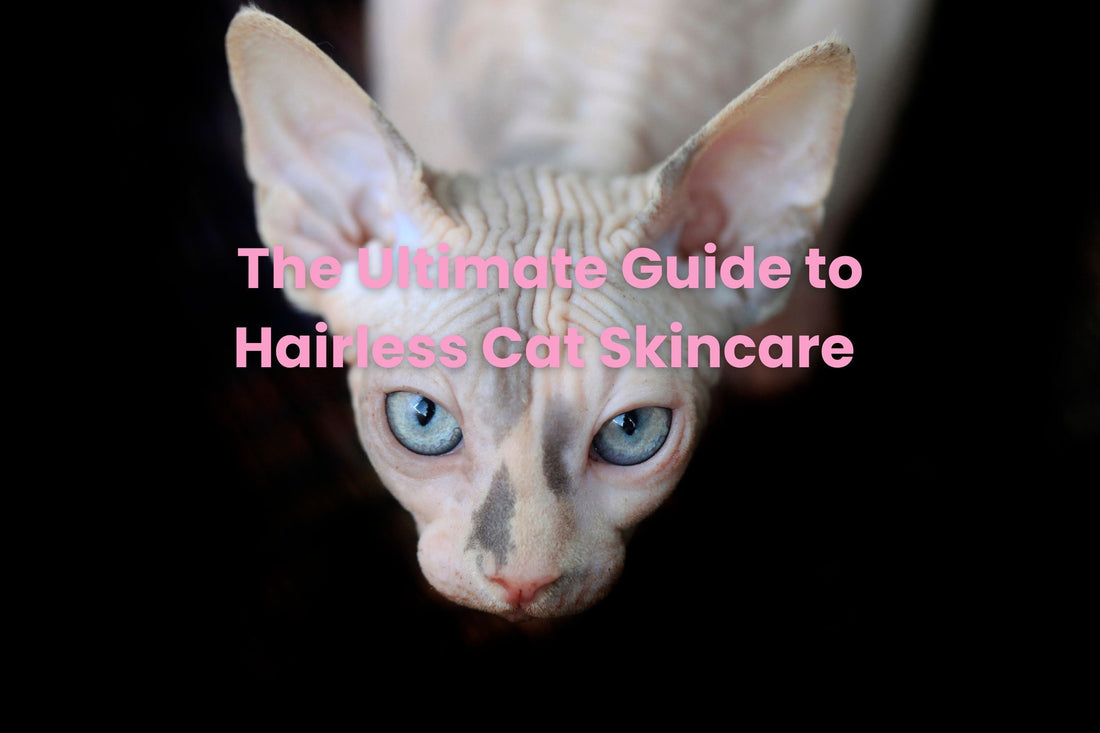
The Ultimate Guide to Hairless Cat Skincare: Everything You Need to Know
Share
Introduction
Hairless cats have unique skincare needs that set them apart from their furry counterparts. Without a protective coat, their skin is directly exposed to environmental factors like dust, oil buildup, and sun exposure. As a result, maintaining healthy skin requires a dedicated routine that focuses on gentle cleansing, hydration, and protection.
Many new hairless cat owners assume frequent bathing is necessary, but this can often do more harm than good. Over-washing strips away natural oils, leading to excessive oil production as the skin tries to compensate, which can result in greasiness, dryness, or irritation. The key is understanding how to support their skin’s natural defenses while preventing common issues such as excessive oil production, dryness, and irritation. This guide will cover everything you need to know about hairless cat skincare, from bathing frequency to choosing the right products and preventing skin problems.
1. Understanding Hairless Cat Skin
Hairless cats have a delicate skin microbiome and protective barrier that must remain balanced to stay healthy. Unlike coated breeds, their skin is more vulnerable to external irritants, making proper care essential.
- The Role of the Skin Barrier – This outermost layer helps retain moisture and prevent harmful bacteria from causing irritation.
- Why pH Balance Matters – A cat’s skin has an optimal pH of 6.0, meaning products formulated for humans or dogs may be too harsh and disrupt its natural balance. Learn how pH is important for hairless cats.
- Differences from Coated Breeds – Without fur to absorb oils, hairless cats tend to accumulate oil and dirt more visibly, requiring a tailored skincare approach.
2. How Often to Bathe a Hairless Cat
Many assume hairless cats need weekly baths, but frequent washing can actually lead to increased oil production and skin imbalance. Instead, most hairless cats thrive with a bath every 2–4 weeks, depending on their individual needs. Find the ideal bathing schedule here.
- Why Over-Bathing is Harmful – Stripping the skin of natural oils can cause excessive sebum production, leading to greasy skin.
- Establishing a Bathing Routine – Observing your cat’s skin condition and adjusting the schedule accordingly is key to maintaining balance.
- Tips for a Stress-Free Bath – Use warm water, a soft cloth, and a pH-balanced, cat-specific cleanser to cleanse gently. Discover more tips and tricks for bathing your cat.
Just brought home a kitten? It’s best to give them at least a week to settle into their new home before attempting a bath. For a full walkthrough on timing, technique, and kitten-safe products, read our detailed guide: Your Sphynx Kitten’s First Bath.
3. Choosing the Right Skincare Products
Selecting the right skincare products is essential for maintaining a hairless cat’s skin health. Many general pet shampoos are designed for coated breeds and may contain ingredients that are too harsh for exposed skin, leading to dryness or irritation. Choosing products specifically formulated for hairless cats ensures their delicate skin remains balanced and protected. Many shampoos and cleansers contain harsh ingredients that can strip moisture and cause irritation. Here's why the best hairless cat shampoo isn't a shampoo at all!
What to Look for in a Cleanser:
- pH-balanced (around 6.0) for feline skin
- Free from sulfates, parabens, and artificial fragrances
- Made from naturally sourced, non-toxic ingredients
Ingredients to Avoid:
- Sulfates (SLS, SLES) – Harsh surfactants that strip natural oils
- Parabens & Artificial Fragrances – Potential irritants
- Essential Oils & Petrochemicals – Can be harmful if ingested through grooming
4. Sun Protection for Hairless Cats
Without fur, hairless cats are especially vulnerable to sunburn, hyperpigmentation, and long-term UV damage, which can increase the risk of skin cancer and chronic skin conditions over time. While SPF products may seem like a solution, they often contain toxic ingredients that are unsafe for feline grooming habits. See what works (and what doesn't).
Safer Alternatives to SPF:
- UV-blocking window films to reduce sun exposure indoors
- Limiting sunbathing time, especially between 10 AM – 4 PM
- Protective UV clothing designed for cats
5. Common Skin Problems & How to Prevent Them
The following are general tips for holistic skin health and regular maintenance. For severe skin conditions such as hives, open sores, or infections, consult a veterinarian for proper diagnosis and treatment.
Hairless cats are prone to skin imbalances that require close monitoring. These imbalances can manifest as excessive oiliness, dryness, flakiness, irritation, or even recurring skin infections. Keeping a consistent skincare routine helps maintain the skin's natural balance and prevent discomfort. Here’s how to recognize and prevent some common issues:
Greasy Skin
- Cause: Overproduction of oil due to harsh cleansers or excessive bathing
- Solution: Use a mild, pH-balanced cleanser and reduce bathing frequency
Dry, Flaky Skin
- Cause: Insufficient hydration or exposure to irritants
- Solution: Provide moisturizing care with safe nourishing oils. Learn about the benefits of moisturizing and conditioning hairless cat skin.
Skin Irritation & Infections
- Cause: A compromised skin barrier and an imbalanced microbiome.
- Solution: Rehabilitate the skin by using mild, natural, cat-specific skincare Eliminate all human and other animal products from their routine to prevent further disruption. Here's how to fix a broken skin barrier.
6. Diet & Internal Health for Healthy Skin
A balanced diet plays a key role in maintaining healthy skin. Since cats are obligate carnivores, their nutritional needs differ significantly from other pets.
- High-Quality Protein – Cats require a diet rich in animal-based protein to support skin health and natural oil production.
- Essential Fatty Acids – Omega-3 and Omega-6 help maintain skin hydration and reduce inflammation.
-
Avoiding Food Allergies – Some hairless cats develop food sensitivities that contribute to skin irritation. If allergies are suspected:
- Try an elimination diet to identify triggers.
- Consult a veterinarian for guidance on hypoallergenic diets.
7. Long-Term Skincare Routine & Preventative Care
To keep your cat’s skin in top condition, consistency is key.
- Clean bedding regularly to prevent oil buildup and bacteria
- Monitor for changes in skin texture, redness, or irritation
- Adjust skincare based on seasonal needs (e.g., more hydration in winter, sun protection in summer)
- Get regular veterinary check ups that include examination of any acute or chronic skin issues.
Conclusion: Supporting Your Hairless Cat’s Skin for Life
By using gentle, pH-balanced skincare products and maintaining a consistent, cat-safe routine, you can prevent many common skin issues and keep your cat comfortable. Pay attention to any changes in your cat’s skin, such as increased oiliness, dryness, or irritation, as these can indicate a need to adjust their skincare routine. Skincare doesn’t have to be complicated, but it does need to be tailored to the unique needs of hairless cats.
Explore Our Hairless Cat Skincare Collection
For naturally formulated cleansers and moisturizers designed specifically for hairless cats, explore our collection today.
Frequently Asked Questions
Q: Can I use baby wipes to clean my hairless cat between baths?
A: Instead of baby wipes, which often contain fragrances, preservatives, and chemicals that can irritate your cat’s skin, try using our Waterless Cleansing Foam. Simply apply a small amount to a soft cloth to create a safe, gentle wipe that removes dirt and excess oil without disrupting the skin barrier.
Q: How should I bathe my Sphynx kitten for the first time?
A: Bathing a hairless kitten for the first time can be a bit nerve-wracking—but with the right prep, it can be a calm and even bonding experience. The key is to go slow, use warm (not hot) water, and choose a gentle, pH-balanced cleanser made for sensitive skin. Avoid submerging their head, and always have a warm towel ready.
If you’ve just brought your kitten (or adult cat) home, it’s best to wait at least a week before attempting a bath. Giving them time to adjust to their new home and family helps reduce stress and builds trust, making future grooming much easier.
For a full walkthrough on when to start and what to expect, read our detailed guide: Your Sphynx Kitten’s First Bath.
Q: Why does my hairless cat’s skin feel sticky or tacky?
A: Sticky skin is often caused by excess oil buildup due to over-bathing, humidity, or improper cleansing. Try reducing bathing frequency and use our Soothing Skin Cleanser, which gently cleanses while supporting the skin barrier to maintain a healthy balance. Regular use of our Revitalizing Skin Elixir after bathing can also help restore balance to the skin.
Q: How do I know if my cat needs moisturizer?
A: If your cat’s skin is flaky, rough, or has dry patches, a light, cat-safe moisturizer can help restore hydration. Our Revitalizing Skin Elixir, formulated with naturally sourced oils, provides moisture without clogging pores or causing excessive oil production.
Q:My cat gets dirty quickly between baths—what can I do?
A: To keep your cat’s skin clean longer, use our Waterless Cleansing Foam with a soft cloth as a daily wipe-down. Ensure their bedding is washed regularly, and avoid harsh cleansers that strip natural oils, which can lead to faster oil buildup.
Q: What’s the best way to clean my cat’s paws and nails?
A: The paws and nails can accumulate dirt and oil quickly. Many customers find that oil-based solutions help loosen and remove buildup more effectively than water-based options. Try using our Toe Bean Oil Cleansing Treatment, which helps break down dirt and excess oil while keeping the skin soft and hydrated.
Q: Can I use coconut oil on my hairless cat’s skin?
A: Yes, in moderation and at the right time. Coconut oil can be beneficial when used in a blend or in products that are rinsed off because it is soothing and effective in gently carrying away impurities. However, due to its comedogenic nature, it can clog pores and contribute to oil buildup if overused. That’s why we use it very sparingly in our products, ensuring that it provides hydration without overwhelming the skin. Learn more about the coconut oil and the comedogenic scale.
Ready to give them the skincare products they deserve - SHOP NOW ➡️

